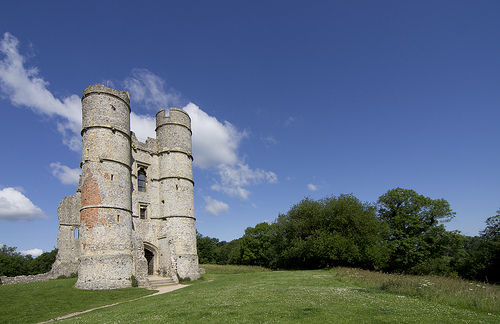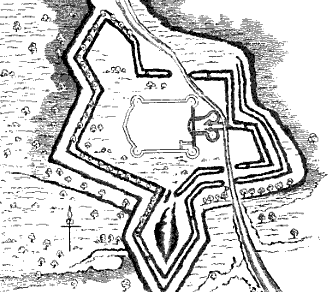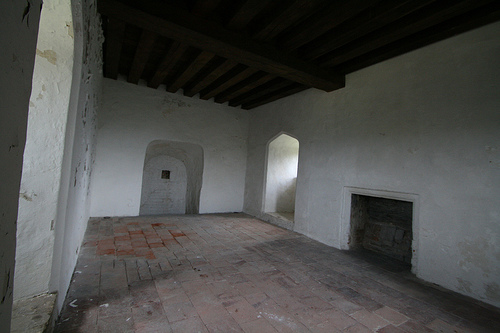

Location: Berkshire Map
Constructed: 1386 by Sir Richard Abberbury the Elder


Donnington Castle is a medieval castle situated near village of Donnington, North of town of Newbury in the Berkshire County in England. It was constructed in 1386 by Sir Richard Abberbury the Elder following a crenellation permit issued by King Richard II of England in 1386. Donnington castle was later purchased by Thomas Chaucer, son of the poet Geoffrey Chaucer, as a residence for his daughter Alice de la Pole, future Duchess of Suffolk. It passed it on to the Tudor family, and the building becomes royal property. King Henry VIII lived tere, along with his daughter, future Queen Elizabeth I; the latter even asked to live there in 1554 during her imprisonment by her sister, Marie Ire, but was not allowed to do so.
The site of Donnington Castle has roots in the late 13th century when
the Abberbury family acquired the manor in 1287 through Thomas
Abberbury's purchase. The castle itself was founded around 1386 by Sir
Richard Abberbury the Elder, a seasoned soldier, courtier, and diplomat
who served under Edward the Black Prince and Richard II. Granted a royal
license to crenellate (fortify) by Richard II in 1386, Abberbury likely
oversaw construction until his death in 1399, just before the king's
deposition. The project, possibly involving master mason William
Wynford, began with the east curtain wall and progressed to the
gatehouse, using local materials for an economical yet elegant build.
Abberbury enhanced the estate with a deer park, fishponds, a chantry
chapel (founded 1366), and a hospital (1393), elevating Donnington's
status as a genteel retreat.
Following Abberbury's death, his son
sold the castle in 1415 to Thomas Chaucer—son of the poet Geoffrey
Chaucer and Speaker of the House of Commons—for 1,000 marks. Thomas
acquired it for his daughter Alice, who through successive marriages
became a pivotal figure: first to Sir John Phelip, then Thomas Montagu
(Earl of Salisbury), and finally William de la Pole (Duke of Suffolk).
As Duchess of Suffolk, Alice held Donnington for over 60 years until
1475, using it as a family seat and patronizing arts and charities,
including refounding the hospital and establishing an almshouse at
Ewelme. Her son John de la Pole inherited but faced treason charges in
1503, leading to Crown seizure. Henry VIII granted it to Charles
Brandon, Duke of Suffolk (who secretly married Henry's sister Mary Tudor
in 1515), in 1512. After Mary's death in 1533, Brandon exchanged it back
to the Crown. The castle hosted royal visits, including Henry VIII in
1541 and Edward VI in 1552, who granted it to his sister Elizabeth
(later Queen Elizabeth I).
Under Elizabeth I, the castle passed
through various hands: granted to Elizabeth, Lady Russell, as keeper in
1590 (notably one of the first women in such a role), then to Charles
Howard, Earl of Nottingham, in 1601 amid disputes. Nottingham's daughter
sold it in 1624, and by 1632, it belonged to John Packer. Donnington's
pivotal moment came during the First English Civil War (1642–1646).
After the First Battle of Newbury in 1643, Royalists under Colonel Sir
John Boys garrisoned the strategically vital site, fortifying it with
star-shaped earthworks. Parliamentarians besieged it from July 1644,
bombarding the structure over 20 months with heavy artillery, but Boys
held out heroically until surrendering in April 1646 to avoid further
bloodshed. Parliament ordered slighting (partial demolition) in 1646 to
prevent reuse, leaving the castle in ruins. Packer recovered the manor
but abandoned the damaged site for Donnington Castle House, an
Elizabethan lodge at the hill's base.
In the 18th century, the Packer
family retained ownership until mid-century, when it passed to the
Winchcombe family via marriage; Winchcombe Henry Hartley owned it from
1833 to 1881. By the late 18th century, the gatehouse had become a
romantic landmark, repaired with red brick and augmented by a
Gothick-windowed cottage for a custodian. The estate was divided in
1907, and ruins bought by E. Festus Kelly in the 1920s. Scheduled as an
Ancient Monument in 1925, it entered Crown guardianship in 1952, with
repairs and clearances following, including a 1956 custodian's hut. It
opened to the public shortly thereafter and remains a cared-for heritage
site.
Donnington Castle exemplifies a quadrangular plan, a popular
late-medieval design enclosing a courtyard within curtain walls for
residential security. Roughly rectangular (with an irregular
westward projection), it measured about 108 feet east-west by 67
feet north-south internally. The enclosure featured a flint rubble
and chalk curtain wall, about 1.5 meters thick and rendered white
for visibility, with four round corner towers and two square
intermediate towers along the east and west walls—minimalist
defenses lacking a moat or arrow-loops, prioritizing comfort over
siege-proofing. The courtyard housed timber-framed buildings: a
great hall, private chambers, guest quarters, chapel, kitchens, and
services, with the gatehouse accommodating the steward separately.
The sole major survival is the grand twin-towered gatehouse on the
east side, rising to 65 feet (three storeys) with internal
dimensions of 17.5 by 11.75 feet. Built circa 1386–1399, it boasts a
vaulted passage with fine ribbed stonework, possibly by William
Wynford, flanked by D-shaped towers pierced by narrow loops for
defense. Battlemented at the top, it included a portcullis and
drawbridge (now gone). During the Civil War, Royalists added
Italianate "star" earthworks—diamond-shaped bastions and scarps up
to 1.7 meters high—for artillery, encircling the ruins and adapting
medieval stone to gunpowder-era warfare. Modern low walls (0.5
meters) outline the original layout for visitors. The overall
design, economical yet refined, transitioned from a whitewashed
manor-like fortress to a battered Civil War redoubt.
The gatehouse stands as the castle's icon, its weathered towers evoking medieval grandeur amid grassy earthworks—depicted in art, album covers (e.g., Tenpole Tudor's 2001 compilation), and media like The Saint (1966) and A Hitch in Time (1978). The star forts, rare survivors of 17th-century fieldwork, highlight tactical evolution. The adjacent 14th-century hospital, rebuilt in 1602, endures as Berkshire's oldest charity. No major legends attach directly, but the 20-month siege romanticizes Sir John Boys as a defiant Royalist hero, with tales of his ingenuity against overwhelming odds. Royal associations—Chaucer lineage, Tudor visits—add literary and dynastic allure.
Today, Donnington Castle is a public ruin under English Heritage stewardship, open daily with free entry (donations encouraged). Managed since 1952 as a scheduled monument under the Ancient Monuments and Archaeological Areas Act 1979, it excludes modern intrusions like fences but protects underlying archaeology. The site features interpretive panels, picnic areas, and panoramic views, drawing history enthusiasts for walks and events. No recent major changes as of 2025; ongoing conservation preserves the gatehouse and earthworks against weathering. Nearby Donnington Castle House serves as a private residence, while the hospital continues charitable work. As a testament to 600 years of conflict and continuity, it remains a poignant Berkshire landmark.